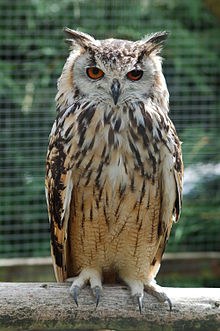Eagle-owl
| Horned owls and eagle-owls Temporal range: Late Pliocene to present |
|
|---|---|
 |
|
| Indian eagle-owl, Bubo bengalensis | |
| Scientific classification | |
| Kingdom: | Animalia |
| Phylum: | Chordata |
| Class: | Aves |
| Subclass: | Neornithes |
| Infraclass: | Neognathae |
| Superorder: | Neoaves |
| Order: | Strigiformes |
| Family: | Strigidae |
| Genus: |
Bubo Duméril, 1805 |
| Species | |
|
About one or two dozen, see text |
|
| Synonyms | |
|
Huhua |
|
About one or two dozen, see text
Huhua
Nyctea Stephens, 1826
Ophthalmomegas Dejaut, 1911 and see text
The American (North and South America) horned owls and the Old World eagle-owls make up the genus Bubo, at least as traditionally described. The genus name Bubo is Latin for the Eurasian eagle-owl.
This genus, depending on definition, contains about one or two dozen species of typical owls (family Strigidae) and is found in many parts of the world. Some of the largest living Strigiformes are in Bubo. Traditionally, only owls with ear-tufts were included in this genus, but that is no longer the case.
(mtDNA) sequence data supports the decision to consider the snowy owl an eagle-owl adapted to Arctic conditions and moving it into Bubo, rendering the monotypic genus Nyctea invalid.
The four fish-owls previously in the genus Ketupa were provisionally moved into Bubo as well. However, the mtDNA cytochrome b data suggests that in this case, to make Bubo monophyletic the Scotopelia fishing owls would also need to be included there. On the other hand, the genus then becomes quite large and ill-defined, and Bubo in the expanded sense seems to consist of two distinct clades. Thus, the fish and fishing owls can alternatively be united in Ketupa if some aberrant eagle-owls – at least the barred, spot-bellied and Usambara eagle-owls, perhaps also Fraser's eagle-owl and maybe others – are moved into that genus too. As some enigmatic eagle-owls remain essentially unstudied and others – e.g. Verreaux's eagle-owl – are of unresolved relationships, more research is needed.
...
Wikipedia
